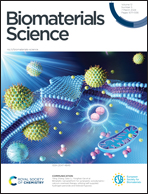Visualization of therapeutic intervention for acute liver injury using low-intensity pulsed ultrasound-responsive phase variant nanoparticles†
Abstract
Acute liver injury (ALI) is a highly fatal condition characterized by sudden massive necrosis of liver cells, inflammation, and impaired coagulation function. Currently, the primary clinical approach for managing ALI involves symptom management based on the underlying causes. The association between excessive reactive oxygen species originating from macrophages and acute liver injury is noteworthy. Therefore, we designed a novel nanoscale phase variant contrast agent, denoted as PFP@CeO2@Lips, which effectively scavenges reactive oxygen species, and enables visualization through low intensity pulsed ultrasound activation. The efficacy of the nanoparticles in scavenging excess reactive oxygen species from RAW264.7 and protective AML12 cells has been demonstrated through in vitro and in vivo experiments. Additionally, these nanoparticles have shown a protective effect against LPS/D-GalN attack in C57BL/6J mice. Furthermore, when exposed to LIPUS irritation, the nanoparticles undergo liquid–gas phase transition and enable ultrasound imaging.



 Please wait while we load your content...
Please wait while we load your content...